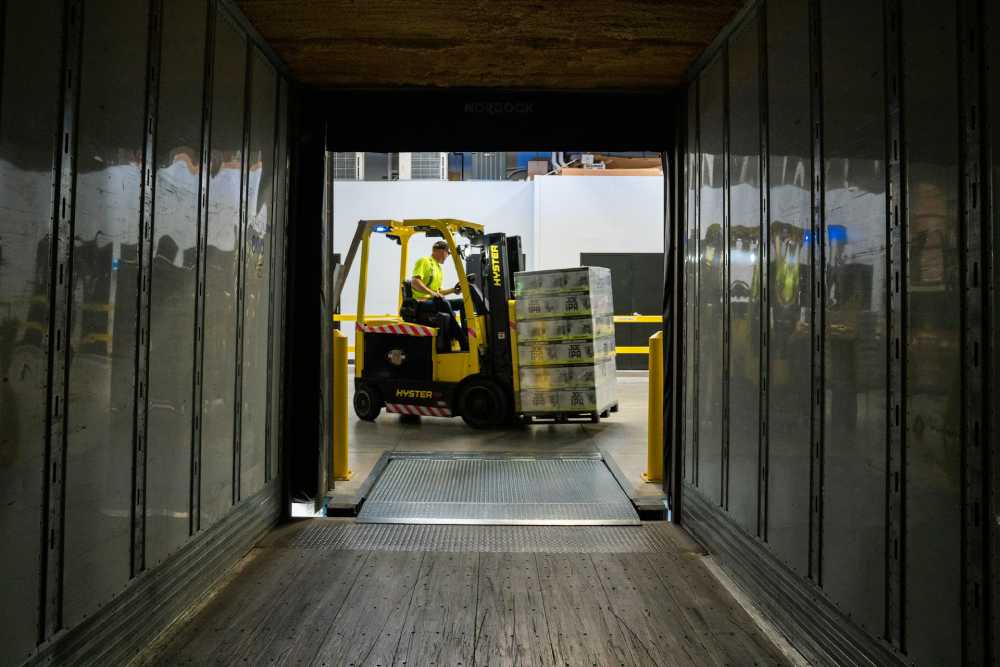Globalization has amplified the importance of efficient freight solutions, where pallet shipping stands as a cornerstone strategy in logistics. Embracing simplified pallet shipping cost models is not just a fiscally sound choice but also a benchmark of ingenuity.
Industries are poised to leverage efficiency and foster healthier customer relationships across vast global networks by weaving cost transparency into shipping rates.
Understanding Pallet Shipping and Its Significance
Pallet shipping is an intricate piece of the logistics puzzle, a practice that enriches trade by streamlining the process of moving goods worldwide.
Pallets are more than just wooden or plastic platforms; they revolutionize how products journey through the supply chain, ensuring secured delivery and handling efficiencies. Such uniformity paves the way for seamless operations and systematized warehousing, whether goods travel locally or across oceans.
This method’s prevalence is due to the array of advantages it offers. These include but are not limited to bolstering labor efficiencies, slashing the time spent on handling, and substantially mitigating the risk of product damage during transit.
By vastly reducing manual handling, palletized shipments can move more swiftly through logistical pathways, adapting to the ever-varying pulse of global demands.
The Shift Toward Simplified Pallet Shipping Rates
Traditional methods for calculating a pallet shipping cost can be intricate, often leading to confusion and inefficiencies.
However, there has been a notable shift towards implementing simplified rate models for shipping in recent years. These models prioritize transparency and can significantly reduce administrative burdens, resulting in more transparent communication and expectations between shippers and clients.
Shippers can allocate more resources to improve service delivery by eliminating unnecessary complexities and ensuring products reach their destination within predetermined timeframes and budgets.
The implications of embracing a simplified approach to shipping rates extend beyond mere cost calculations. They offer businesses an opportunity to enhance operational transparency and integrity. Consequently, this can increase client satisfaction, establishing a solid foundation for enduring business relationships and fostering an environment of mutual trust and dependability.
Cost Factors Involved in Pallet Shipping
While simplified pricing structures are becoming more prominent, understanding the nuance behind the costs remains crucial. A comprehensive grasp of how pricing is influenced by weight, distance, and additional surcharges is indispensable for any business looking to harness control over its shipping expenditures.
Demystifying these elements ensures that businesses aren’t merely subjects to the whims of logistics but are active participants in sculpting their shipping destinies. It is well-understood in the industry that the more significant and further a shipment must travel, the steeper the cost.
Such a model inherently promotes compact and efficient packaging, incentivizing optimizing every square inch of space within a container. In effect, this prioritizes thoughtful logistics planning and pushes businesses to consolidate shipments and use routing strategies to lower costs without sacrificing the quality of service provided.
Efficient Supply Chain Management with Pallet Shipping
Supply chains are intricate systems, and the role of cost-effective pallet shipping in optimizing these networks cannot be overstated. The correlation between competitive shipping rates and a healthy supply chain is self-evident.
Yet, businesses find profitability and resilience in the finesse of integrating pallet systems into broader logistical strategies. Shrewd management of pallet shipping affects overall costs and, by extension, the operational fluidity of businesses—transforming them into flexible entities capable of weathering the erratic nature of market trends.
Managing a supply chain implies a relentless quest for improvement and sustainability. An efficient supply chain is a symphony of moving parts, and pallet management is akin to reading a conductor’s cue—pivotal for synchronization.
Whether it involves pooling resources for reusable pallets or investing in sturdier pallet designs for enhanced durability, every step toward more competent pallet management can significantly impact an organization’s supply chain prowess.
Technology’s Role in Streamlining Shipping Rates
The brushstrokes of technology have irrevocably changed the logistical world’s canvas. As logistical complexity escalates, software solutions for freight management shine as beacons of innovation, offering unprecedented clarity and precision in rate calculation.
With the industry’s adoption of these digital tools, companies can more easily navigate the intricacies of rate structures, finding cost-efficiency and strategic advantages in real-time data and algorithm-driven decision-making.
Furthermore, we are witnessing a surge in the application of automation and artificial intelligence to refine the shipping process. These technologies manifest as intelligent route planning applications, automated billing systems, and AI-driven analytics that forecast demand and adjust rates accordingly.
Such capabilities are not just the future—they are the present—and embody the leap toward a future where logistics is seamlessly integrated, predictive, and adaptive to the contours of global demand.
Challenges and Solutions in Pallet Rate Pricing
As much as simplified rates benefit the logistics realm, the overarching system still faces formidable headwinds. Shippers battle against fluctuating overheads like fuel costs and grapple with unexpected changes in supply, such as the recent pallet shortages that have caused disruptions and cost fluctuations in the market.
Amidst such challenges, ingenuity flourishes; new pooling systems and recycled materials are some strategies to circumvent these issues.
Businesses aren’t bystanders to these logistical challenges; they are active problem solvers seeking innovative solutions. Rental programs, asset tracking, and comprehensive pallet management systems are being utilized to maintain a constant flow of materials, sidestepping potential crises and maintaining stasis in pricing mechanisms despite the tides of change upending availability and cost.
Analyzing the Environmental Impact of Pallet Shipping
The logistics sector is in the throes of a green revolution. Sustainability is not just a buzzword; it’s a revolutionary approach shaping the practices of the shipping industry. Addressing the substantial environmental footprint of traditional pallet shipping practices is of paramount concern, as it ties directly into global efforts to curtail emissions and reduce waste.
A mosaic of initiatives emphasizing eco-friendly materials and sustainable operations is surfacing, serving the dual purpose of complying with emerging regulatory standards and catering to the increasingly green expectations of customers.
Futuristic and yet deeply pragmatic efforts in the sector cover the gamut from research into biodegradable pallet materials to more efficient recycling and repurposing programs.
Innovative designs and lifecycle management concepts ensure that sustainability is embedded into the core processes of pallet usage. These shifts underscore a broader commitment to reducing the environmental impact of shipping practices and resonate with the conscientious consumer base’s ethos.
Case Studies: Success Stories in Pallet Shipping Optimization
The realm is rife with success stories, painting a vibrant picture of companies that have adeptly harnessed innovative pallet shipping practices. By integrating nuanced pricing strategies into their operations, these trailblazers have carved paths of efficiency and cost reduction while maintaining, if not enhancing, the quality of their logistics services.
These illustrative examples provide a treasure trove of insights and demonstrate the tangible benefits that can arise from the thoughtful implementation of such logistical strategies.
Amidst these narratives, green initiatives have emerged as a distinctive theme. As detailed in the Wall Street Journal, there are notable instances where companies have garnered attention through a steadfast commitment to environmental stewardship while managing their pallet operations. Such acts contribute to a more sustainable supply chain and signal stakeholders a commitment to responsible corporate practices.
Predicting the Future of Pallet Shipping Rates
The question of where pallet shipping rates are headed is one of strategy as much as it is of speculation. Drawing from historical trends and emerging technologies, experts in the field venture to forecast how the rate landscape will evolve. By analyzing the present and peering into the crystal ball of logistics, we can prepare for the cadence of change that defines this dynamic marketplace.
Global trade is constantly in flux, influenced by economic shifts, political changes, and technological breakthroughs. To thrive amidst these tides, businesses must track and anticipate the factors influencing shipping rates.
Staying informed and agile ensures strategic resilience, enabling organizations to pivot as necessary and secure their position within the ever-shifting tableau of global logistics.
Practical Tips for Shippers and Carriers
A welter of practical measures beckons for shippers and carriers eager to plumb the depths of tactical efficacy in pallet shipping. From the art of negotiation to the strategic use of consolidated shipments, operations can be honed for financial savviness and service excellence.
The following practical tips can offer a compass for navigating the complexities of the logistics landscape, ensuring a robust and advantageous approach to pallet management.
Engaging carriers in transparent and productive dialogue, leveraging volume discounts, and keeping abreast of the latest shipping rates are strategies that can prove instrumental. By understanding the variables at play and applying a strategic lens to logistics operations, shippers and carriers can navigate the ecosystem of pallet shipping with confidence and understanding.
We discern a tapestry interwoven with complexity and opportunity through the preceding exploration. The evolution of pallet shipping rate pricing is a testament to the innovations shaping modern supply chains.
By espousing simplified cost models, leveraging emerging technologies, and espousing environmentally conscious practices, enterprises optimize their logistics and align with a sustainable and proficient global trade network vision.





